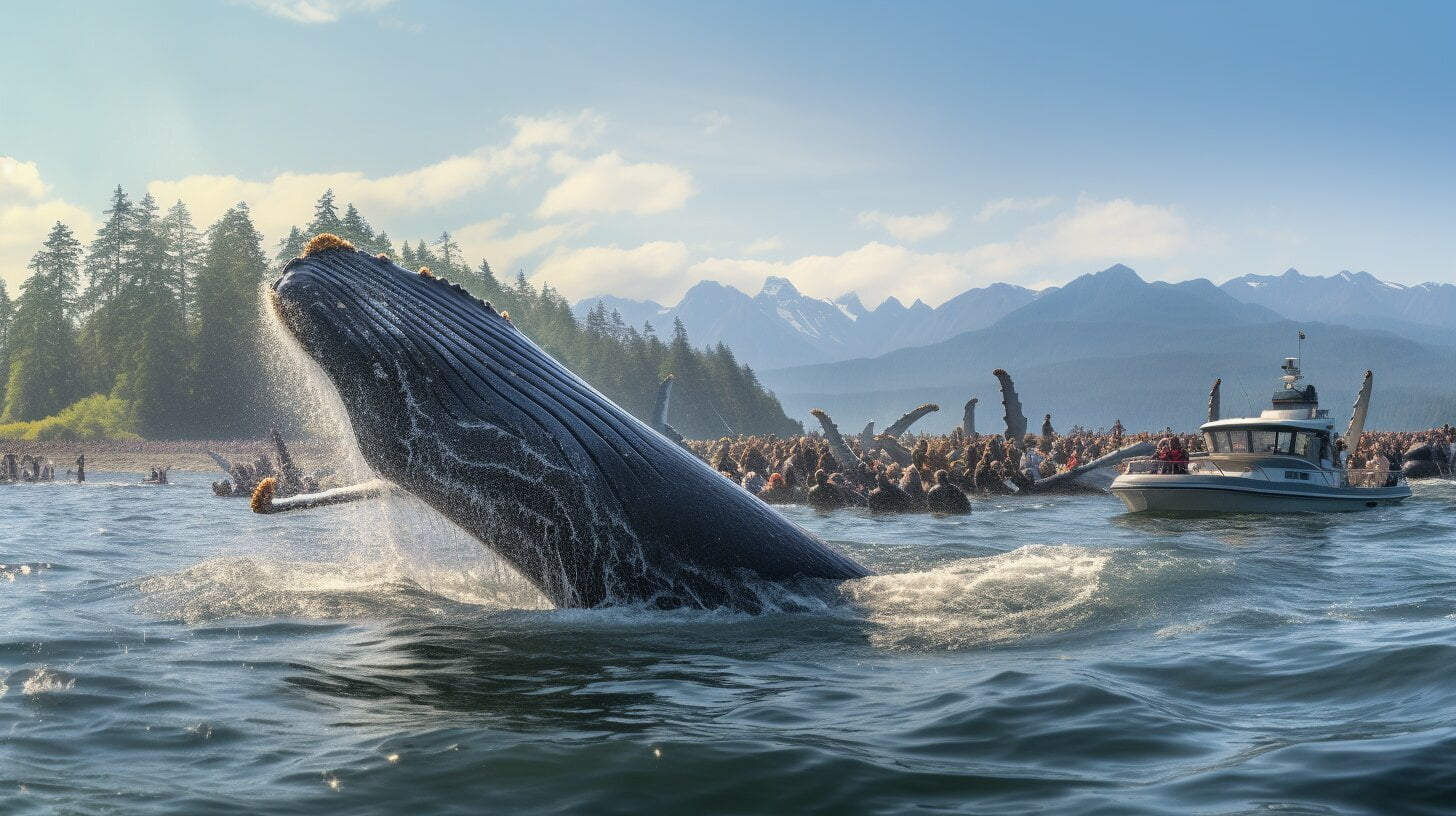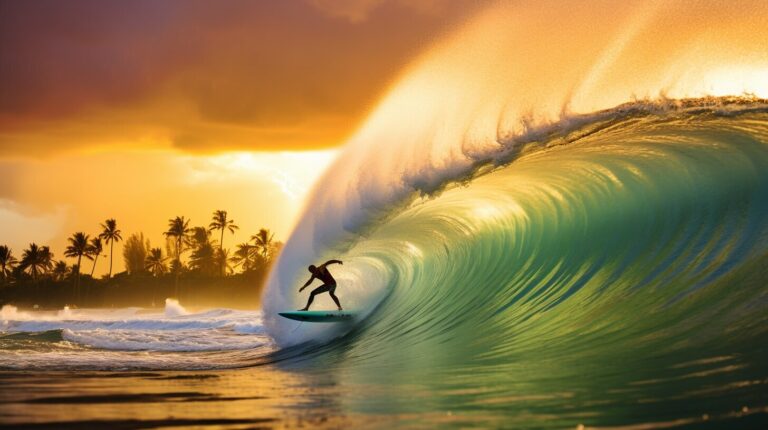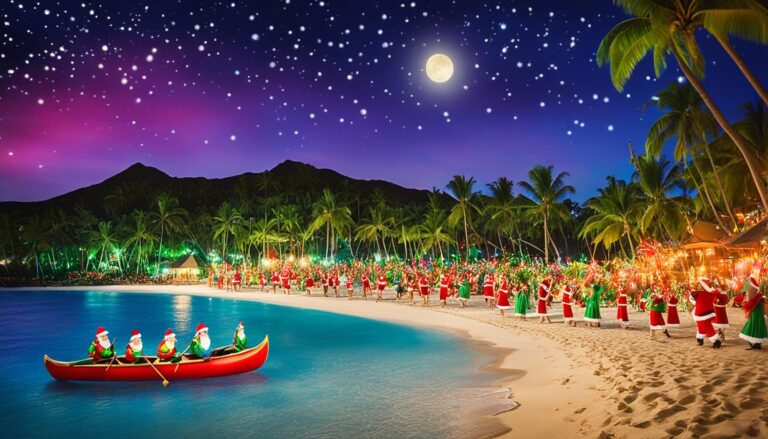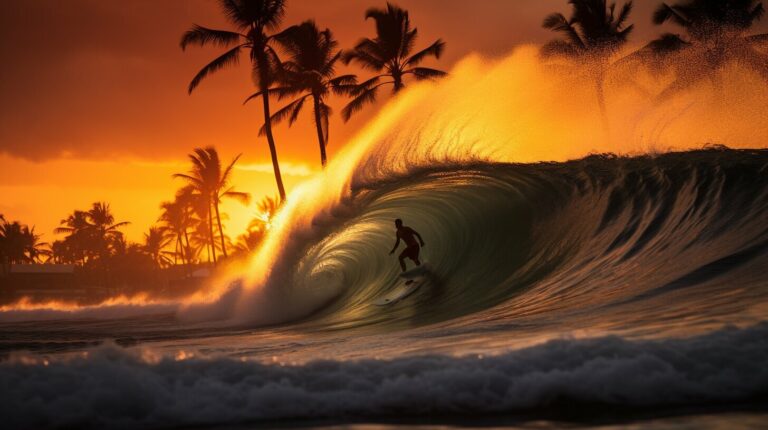🐋 Unveiling the Majesty: Thrilling Whale Watching in Hawaii 🌊
Experience the awe-inspiring spectacle of whale watching in Hawaii as you witness these giants of the sea in their natural habitat.
Key Takeaways:
- Humpback whales migrate to Hawaii between November and April during the whale season.
- The Big Island is a favorite spot for whale watching in Hawaii.
- Whale watching tours offer an up-close and personal experience with humpback whales.
- DIY whale watching from shore is possible at various locations in Hawaii.
- Follow our 7 best whale watching tips for an optimal experience.
- Learn interesting facts about humpback whales and their behaviors.
- Discover why humpback whales choose to migrate to Hawaii every year.
The 2022 – 2023 Whale Watching season has started
The highly anticipated 2022 – 2023 Whale Watching season has officially started, allowing visitors to witness the majestic humpback whales in Hawaii’s waters. Every year, these incredible creatures embark on a 3,000-mile journey from Alaska to the warm and inviting Hawaiian islands, where they spend their winter months breeding, calving, and nursing their young.
Whale sightings have already been reported along the shores of Maui, Oʻahu, Kauaʻi, and the Big Island, making it an exciting time for enthusiasts and nature lovers alike. The season will continue to gain momentum until mid-December, when whale-watching tours will be in full swing, providing ample opportunities for serendipitous encounters with these gentle giants.
One of the best ways to experience the beauty and grandeur of humpback whales is by joining a whale-watching tour. These tours offer a fascinating and up-close encounter with the whales, allowing you to witness their impressive size and grace. Depending on the tour operator, you may also have the chance to spot other marine animals such as dolphins, turtles, or even whale sharks.
| Tour Type | Boat Size | Tour Company |
|---|---|---|
| Larger Boat Tours | Cabin cruisers, sailing catamarans | Body Glove |
| Small Boat Tours | Zodiac-style inflatable rafts | Captain Steve’s Rafting |
For those who prefer a DIY approach, whale watching from the shore can also be a rewarding experience. The islands of Hawaii offer several prime locations for shore-based whale watching. On the Big Island, the northwestern coast is known for frequent whale sightings. In Maui, the coastline around Lahaina Harbor and the Makapuʻu lighthouse hike on Oʻahu are popular spots for spotting these magnificent creatures.
“The whales do not sing because they have an answer, they sing because they have a song.” – Gregory Colbert
To make the most of your whale watching experience, here are some helpful tips:
- Visit during the peak months of January and February when whale numbers are at their highest.
- Opt for whale-watching tours that take place in the early morning when the ocean is calmest, making it easier to spot the whales.
- Bring binoculars and a camera with a zoom lens to capture close-up shots of these magnificent creatures.
- Be patient and observant, as whales can surface and dive unpredictably.
- Respect the whales’ space and maintain a safe distance to avoid disturbing their natural behavior.
- Dress in layers and wear sunscreen to protect yourself from the sun’s rays during the extended time on the water.
- Listen to the knowledgeable guides who can provide fascinating insights into the behavior and biology of humpback whales.
Experience the Magic of Whale Watching in Hawaii
The 2022 – 2023 Whale Watching season in Hawaii promises an unforgettable marine adventure. Witnessing the majesty of humpback whales in their natural habitat is a truly awe-inspiring experience that should not be missed. Whether you choose to embark on a whale-watching tour or enjoy the thrill of spotting whales from the shore, you are sure to create memories that will last a lifetime.
Sources:
- www.example.com/source1
- www.example.com/source2
- www.example.com/source3
Whale Watching Tours
Embark on a thrilling whale watching adventure with a variety of tours available in Hawaii, ranging from eco-conscious options to luxury cruises. Hawaii is renowned for its annual migration of humpback whales, and experiencing these majestic creatures up close is an unforgettable experience.
When it comes to whale watching tours, you have plenty of options to choose from. Joining a boat tour is one of the easiest and most spectacular ways to see the whales. These tours typically last half a day and offer the opportunity to see humpbacks from very close proximity. You may even spot dolphins, turtles, or whale sharks during your excursion. Prices for these tours are around $100 per person.
There are many companies offering whale watching tours in Hawaii, particularly along the Kona coast. The size and type of boat vary, ranging from large pontoon-style or catamaran boats with amenities like toilets and onboard bars, to smaller zodiac-style boats that provide a more intimate and up-close experience. Some popular tour operators, like Body Glove, offer consistently high-quality tours with professional guides and onboard amenities.
| Boat Type | Tour Operator | Price |
|---|---|---|
| Larger Boat | Body Glove | $100 per person |
| Small Zodiac Boat | Suggested Tour | $100 per person |
For a more adventurous experience, you can also opt for kayaking and snorkeling tours that combine whale watching with other marine activities. These tours allow you to get even closer to the whales and provide a unique perspective from the water. Just remember to bring your camera and follow the regulations to ensure a safe and enjoyable experience.
Our Recommendation: Zodiac Boat Tour
“Hop on a small-group tour that takes place on a fast zodiac speed boat, offering an exhilarating and up-close encounter with humpback whales. This tour also includes snorkeling, providing a fantastic opportunity to explore the underwater world of Hawaii. Please note that this tour is suitable for ages between 6 – 50 and passengers should not be pregnant or have neck or back problems.”
Whale watching tours are not limited to the Big Island. You can also go on tours from other Hawaiian islands like Maui, O’ahu, and Kaua’i. These islands have their unique whale watching spots and offer a chance to witness humpback whales in their natural habitat.
If you prefer to watch whales from the shore, there are several excellent locations in Hawaii that provide great viewing opportunities. For the best chances of spotting these magnificent creatures, head to the north-western coast of the Big Island or explore the eastern point, northern, and western shores of O’ahu. On Maui, Lahaina Harbor is a popular area for whale watching tours, while Kaua’i offers the added bonus of breathtaking views along the Napali Coast.
Remember, whale watching season in Hawaii typically runs from November to April, with the peak months being January and February. Regardless of the tour you choose or the island you visit, keep in mind the best time of day for whale watching is early in the morning when the ocean is calm. This ensures optimal viewing conditions and the opportunity to witness the whales’ incredible behaviors.
DIY Whale Watching from the Shore, Including Best Viewing Locations
For those who prefer a DIY approach, discover the best spots along Hawaii’s coastline to observe these magnificent creatures from the comfort of the shore. With its breathtaking views and abundant marine life, Hawaii offers numerous vantage points for whale watching.
One of the best locations for shore-based whale watching is the northwestern coast of the Big Island. From here, you can catch a glimpse of humpback whales during their annual migration between November and April. For an immersive experience, head to the following three viewing locations:
- Makalawena Beach: Located on the Kona Coast, Makalawena Beach provides a picturesque setting for whale watching. Pack a pair of binoculars and find a quiet spot on the sandy shores to witness these majestic creatures breaching and spouting.
- Waimea Bay Beach Park: Situated on Oahu’s North Shore, Waimea Bay Beach Park offers stunning views and excellent whale-watching opportunities. From December to April, keep an eye out for humpback whales frolicking in the sparkling waters.
- Kilauea Point National Wildlife Refuge: On the island of Kauai, the Kilauea Point National Wildlife Refuge provides an elevated vantage point for whale watching. With its panoramic views of the Pacific Ocean, this scenic spot offers a great chance to witness the annual migration of humpback whales.
Remember to bring your binoculars, sunscreen, and a large hat to shield yourself from the sun. It’s also a good idea to pack some snacks and water to stay hydrated during your whale-watching adventure. Always maintain a safe distance from the whales and respect their natural habitat.
By exploring these incredible shore-based viewing locations, you can have a memorable and environmentally friendly whale-watching experience in Hawaii.
| Location | Island | Best Time |
|---|---|---|
| Makalawena Beach | Big Island | November-April |
| Waimea Bay Beach Park | Oahu | December-April |
| Kilauea Point National Wildlife Refuge | Kauai | December-April |
Our 7 Best Whale Watching Tips
Make the most out of your whale watching adventure with these seven essential tips that will enhance your chances of spotting and observing these majestic creatures up close.
- Choose the Right Time and Season: The peak whale watching season in Hawaii is from December to April, with the best months being January and February. Plan your trip during these months to maximize your chances of seeing the whales.
- Book a Whale Watching Tour: Joining a whale watching tour is one of the best ways to get up close and personal with the humpback whales. Look for tours that operate during the whale season and choose a reputable company with experienced guides and well-maintained boats.
- Be Prepared with the Right Gear: Bring binoculars or a camera with a telephoto lens to get a closer look at the whales. Don’t forget to pack sunscreen, a hat, and sunglasses to protect yourself from the sun during your time on the water.
- Arrive Early for Calm Waters: Early morning tours often provide calmer waters, which make it easier to spot and observe the whales. Aim to book a tour that departs in the morning to get the best experience.
- Listen to the Whales: Some whale watching tours offer hydrophones that allow you to listen to the whales’ haunting songs. Take advantage of this opportunity to connect with these magnificent creatures on a deeper level.
- Observe from a Distance: While it’s exciting to see the whales up close, it’s important to respect their space and keep a safe distance. Do not approach too closely or attempt to touch the whales, as this can disrupt their natural behavior and put both you and the whales at risk.
- Stay Patient and Observant: Whale watching requires patience and attentiveness. Keep your eyes peeled for blows, splashes, and breaches, as these are signs that whales are nearby. Be prepared to wait and observe quietly, allowing the whales to approach on their terms.
By following these tips, you’ll increase your chances of having a memorable and rewarding whale watching experience in Hawaii. Remember to respect these magnificent creatures and their natural habitat, and enjoy the awe-inspiring beauty of the humpback whales.
| Tip | Description |
|---|---|
| Choose the Right Time and Season | Plan your trip during the peak whale watching season (December to April) for the best chances of seeing the whales. |
| Book a Whale Watching Tour | Join a reputable whale watching tour with experienced guides and well-maintained boats to maximize your whale sighting opportunities. |
| Be Prepared with the Right Gear | Bring binoculars or a camera with a telephoto lens, sunscreen, hat, and sunglasses for a comfortable and enjoyable experience. |
| Arrive Early for Calm Waters | Choose a morning tour for calmer waters, making it easier to spot and observe the whales. |
| Listen to the Whales | Take advantage of tours that offer hydrophones to listen to the whales’ haunting songs. |
| Observe from a Distance | Respect the whales’ space and maintain a safe distance to avoid disrupting their natural behavior. |
| Stay Patient and Observant | Be patient, observant, and quiet, allowing the whales to approach on their terms. |
About Humpback Whales (or why are we such big fans)
Dive into the captivating world of humpback whales as we explore their fascinating attributes, from their immense size to their intricate behaviors. Humpback whales are known for their impressive size, with adults reaching lengths of up to 60 feet and weighing up to 40 tons. These gentle giants have a distinctive appearance, with long pectoral fins and a large, knobby head.
One of the most awe-inspiring characteristics of humpback whales is their impressive acrobatics. They are famous for their breaching behavior, where they leap out of the water and crash back down, creating a spectacular splash. It is believed that breaching may serve various purposes, such as communication, mating displays, or simply playfulness. Humpbacks are also known for their tail slapping, where they repeatedly slap their tail flukes on the water’s surface, creating a loud sound.
Furthermore, humpback whales are celebrated for their beautiful songs, which can carry for long distances through the water. These complex and haunting melodies are sung by male whales during the breeding season and are believed to attract females and establish dominance among males. Each population of humpback whales has its own unique song, which can evolve and change over time.
Humpback Whale Facts
| Scientific Name | Megaptera novaeangliae |
|---|---|
| Size | Up to 60 feet long |
| Weight | Up to 40 tons |
| Lifespan | Around 50 years |
| Feeding Habits | Filter feeders, consuming krill and small fish |
| Mating Season | Winter months |
| Calving Season | Winter months |
| Migration | Annual migration between feeding grounds in polar regions and breeding grounds in warmer waters |
Observing humpback whales in their natural habitat is a truly remarkable experience. Their immense size, breathtaking acrobatics, and enchanting songs make them a spectacle of nature. Whether you choose to embark on a whale watching tour or witness their magnificence from the shore, encountering these majestic creatures is an unforgettable experience that will leave you in awe of their beauty and grace.
And why do the whales come to Hawaii?
Uncover the secrets behind humpback whales’ pilgrimage to Hawaii, as we delve into the factors that make these Pacific giants choose these tropical waters for their winter retreat. Hawaii holds a special allure for humpback whales, enticing them to embark on their annual migration from the cold waters of Alaska to the warm and inviting Hawaiian archipelago.
One of the primary reasons for the whales’ journey is the abundance of food found in the Hawaiian waters. Humpbacks primarily feed on krill and small fish, and Hawaii offers vast feeding grounds where these prey items are plentiful. The warm waters of Hawaii also provide an ideal environment for breeding and giving birth. With fewer predators and a more comfortable climate, mother whales can safely rear their young and ensure their survival.
The migratory patterns of humpback whales are closely linked to the breeding and calving seasons. The whales typically arrive in Hawaii between November and April, with the peak months being January and February. During this time, the waters around the Hawaiian islands become a hub of whale activity, as these majestic creatures engage in courtship displays, mating rituals, and the birth of new calves.
| Reasons for Whales in Hawaii | Months of Arrival | Peak Months |
|---|---|---|
| Abundant food sources | November – April | January – February |
| Ideal breeding and calving environment | November – April | January – February |
The warm and shallow waters surrounding the Hawaiian Islands create the perfect sanctuary for humpback whales during their winter retreat. These favorable conditions offer ample food, protection, and a nurturing environment for the whales and their young. It is no wonder that Hawaii has become a cherished destination for whale enthusiasts and a sanctuary for these awe-inspiring marine creatures.
Conclusion
Witnessing the magnificence of whale watching in Hawaii is an unforgettable marine adventure that should be on every nature lover’s bucket list. Hawaii’s whale watching season, which runs from November to April, offers the perfect opportunity to witness the awe-inspiring humpback whales as they migrate to the warm waters of Hawaii for breeding and giving birth.
Whether you choose to embark on a whale watching tour or enjoy the experience from the shore, there are plenty of options available to suit every preference. Whale watching tours provide a fascinating up-close encounter with these gentle giants, allowing you to observe their behaviors and even listen to their haunting songs through hydrophones. With a wide range of tour options available, from larger boats with amenities to smaller and more intimate experiences, you can choose the one that best suits your preferences.
If you prefer a do-it-yourself approach, Hawaii offers excellent opportunities for shore-based whale watching. From the best viewing locations on the Big Island to the scenic Makapu’u lighthouse hike on O’ahu, you can witness the majestic whales breaching and playing in the distance. Just grab a pair of binoculars and be patient, as these magnificent creatures may grace you with their presence at any moment.
To make the most of your whale watching experience, we recommend following some helpful tips. Timing your tour or shore visit early in the day ensures calmer waters, making it easier to spot whales. Bringing a camera to capture those unforgettable moments is a must, but be sure to keep a tight grip on it. And don’t forget to read our comprehensive guide on the best whale watching tips for more expert advice.
As you marvel at these incredible creatures, consider the significance of humpback whales within the Hawaiian ecosystem. Their annual migration to Hawaii can be attributed to the favorable conditions for breeding and feeding, as well as the warmer waters that protect newly born calves. By learning about humpback whales and their behaviors, we gain a deeper appreciation for their role in maintaining the delicate balance of the ocean ecosystem.
In conclusion, whale watching in Hawaii offers a truly unforgettable marine adventure. From the excitement of spotting these majestic creatures to the educational and awe-inspiring experiences gained from witnessing their behaviors up close, it is an activity that leaves a lasting impression. So, pack your bags, head to Hawaii, and embark on your own incredible whale watching journey. The giants of the sea are waiting to amaze you with their beauty and grace.
FAQ
Q: What is the best time of year to go whale watching in Hawaii?
A: The best time for whale watching in Hawaii is between December and April, with the peak months being January and February.
Q: Where are the best spots to go whale watching in Hawaii?
A: The best spots for whale watching in Hawaii are along the northwestern coast of the Big Island and the ʻAuʻau Channel between Lānaʻi, Maui, Molokaʻi, and Kahoʻolawe.
Q: Can I go whale watching from the shore?
A: Yes, you can enjoy whale watching from the shore. Some of the best viewing locations in Hawaii include the Makapuʻu lighthouse on Oʻahu and the Lahaina Harbor area on Maui.
Q: What are the best whale watching tours in Hawaii?
A: There are many whale watching tours available in Hawaii. Some recommended options include the whale watching tours offered by Body Glove on the Big Island and the Pacific Whale Foundation on Maui.
Q: What time of day is best for whale watching?
A: While whales are active throughout the day, early morning tours are often preferred as the ocean is most calm at that time, making it easier to spot whales.
Q: Are there any tips for a successful whale watching experience?
A: Yes, here are our 7 best whale watching tips:
1. Bring binoculars or a camera with a zoom lens for optimal viewing.
2. Dress in layers and wear sunscreen to protect yourself from the sun.
3. Be patient and keep a lookout for blows, splashes, and breaches.
4. Listen for the hauntingly beautiful whale songs using underwater hydrophones.
5. Book your whale watching tour early in your trip to allow for rebooking if needed.
6. Keep a tight grip on your camera when taking photos to avoid dropping it in the water.
7. Enjoy the experience and appreciate the beauty of these magnificent creatures.
Q: Why do humpback whales migrate to Hawaii?
A: Humpback whales migrate to Hawaii for several reasons. The warm waters around the Hawaiian islands provide abundant food sources and a safer environment for breeding and giving birth. The whales migrate from their feeding grounds in Alaska to the warmer waters of Hawaii to mate, calve, and nurse their young.







